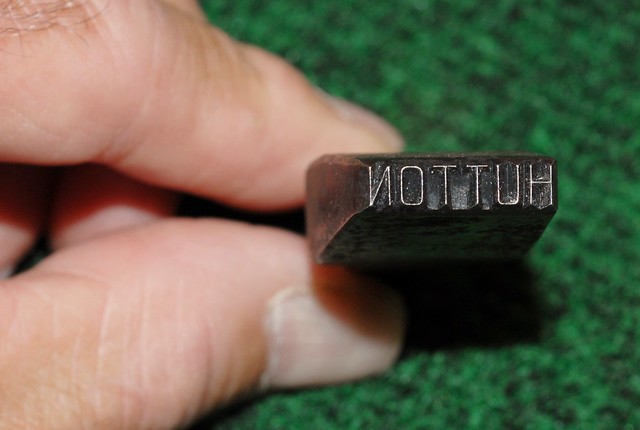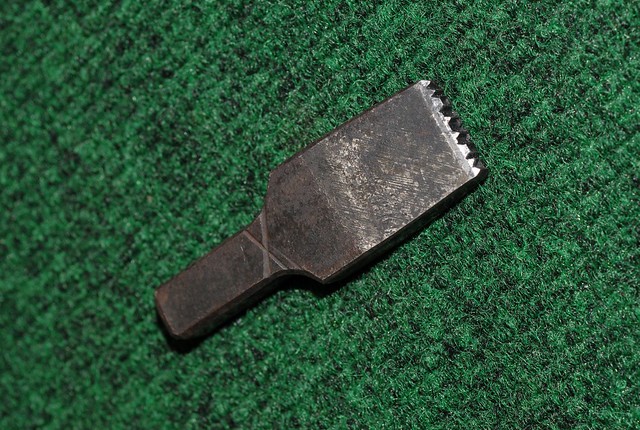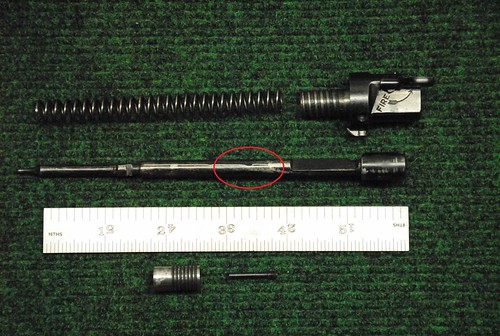April 21, 2018
 Offline
OfflineHowdy TXGunNut,
No, nothing further to add as to the status of the rifle and who may have done the shortening work on it. I do have a couple of other new images to show off, though! I just got back on Jun 13 from a second trip to Colorado to pick up the last of my dad’s stuff that my brother had set aside for me. When I got to looking through my ‘loot’ yesterday, in it I found John Hutton’s stock stamp.


It is the same stamp he used inside my Model 70 stock and the Hutton stock shown in Michael Petrov’s second book.
Best regards………Clint
April 21, 2018
 Offline
OfflineWow, another point was made over the weekend by a gent (aka Kutter) on another forum that I also posted much of this same info about this rifle on. He noted:
“I notice the Bbl and the action both carry a Winchester ‘Postal’ proof mark ‘P in an Oval’ indicating a separate part sold unfitted from the Service/Repair Dept if I understand it right,,and a factory finished firearm proof mark,,the standard WP in an oval.
I don’t think I’ve ever seen that before nor can I think of why both would be there unless the customer purchased parts (bbl and rcv’r) went back to factory once assembled for some sort of work that then required a (re)proof.
Maybe that was the welding work some have said might have been done at the Winchester factory?
Just speculating of course, but the duel proofs on both the bbl and rcv’r caught my attention.”
What does this imply to those of you much more knowledgeable than I? The mystery deepens!
April 21, 2018
 Offline
OfflineHowdy again gents,
I kinda hate to bring up such an old thread again, but felt it was better to do that than to start a new one with just an added photo, thus keeping the info more together. I received the Hutton stocked Winchester Model 70 short action rifle this thread is about from my dad in March of 2017.
My dad, who was a WWII and Korean War vet, passed away at about 11:00 AM on 11-11-2018 (interesting that it was exactly 100 years after, almost to the minute, the signing the peace treaty ending WWI on what used to be known as Armistice Day). On my last trip to CO to see him while he was in hospice care in early Nov., my brother gave me some of the last things dad had kept for himself when first going into an assisted living facility. In that box was a photo which included the Hutton’s, my family and other Hutton friends, taken in the Hutton’s back yard maybe during the summer of 1963, as I looked to be around 14 years old. This is also the only photo I have found so far that my family had showing the Hutton’s.
The folks in this photo are, from L to R: John L. Hutton, possibly a niece of the Hutton’s (whose name is unknown to me), Catherine Hutton (pet name – Totie), myself, my brother Norbert, my father Dave, my mother Lottie, a machinist Cap Shepard (who worked for John at the NBS machine shop) and friends Johnnie & Marie Jenkins. All those known in this photo are now deceased except for my brother and me.
The following photo has been cropped from the original:
This may not add a lot, but sort of finishes things up a bit.
Clint
Sorry, I goofed up and changed the URL of the pictures in this post instead of deleting it, and changing the URLs in the same post I made on or before Dec. 3rd, which I mistakenly deleted. That is why things don’t follow to well at the end here.
April 21, 2018
 Offline
OfflineHowdy gents,
I know that I am beating a dead horse here again, but I finally found time to get with SEEWIN (I’ve always known him as Steve) on a Friday afternoon before Christmas, Dec.14th I think, at his place to have him look over my shortened action Model 70 Hutton Rifle. We don’t live all that far apart and have been acquainted for well over 20 years, seeing each other quite often at local gun shows and belonging to the same gun club.
SEEWIN was impressed with the stock, which he admired and complimented, and then removed it from the barreled action. He noted the word ‘HUTTON’ stamped in the wood ahead of the front action screw, and then had a close look at the metal. One look at the action, and SEEWIN dashed my hopes of this being a factory shortened receiver, but there are now more questions that need to be answered. We’ll get to those later on. The weld itself where the receiver had been cut down by ¾” was obvious and a given. Some of the photos below are exactly the same ones shown or referred to earlier in this post, just cropped or with colored indicators added, and one new photo.
Note in the photo above that there are several small voids in the surface of the action, see the yellow arrows. SEEWIN said the Winchester logo looked suspect. I noticed the last letter of the word ‘WINCHESTER’ and the horizontal line following the word ‘MARK’ both might be left from the original roll mark, and that the rest of the letters in ‘WINCHESTER’ looked to be hand engraved. I have looked carefully at this logo under good magnification, and believe that the photo above bears that out. The ‘R’ is fatter/deeper that the other letters, the line ahead of the word ‘TRADE’ is slimmer and not tapered like the one following ‘MARK’. I saw that the letters in ‘TRADE MARK’ are not all on the same line and some of them appear to be unevenly struck, leading me to believe that these were hand stamped with individual letter stamps.
For a good comparison of this logo with an original roll-marked one, see Louis Luttrell’s photo in post #6 above (click to enlarge). See how much more uniform in depth and width the ‘WINCHESTER’ and ‘—TRADE MARK—’ factory roll-mark letters are and how well all the letters of the words ‘TRADE MARK’ line up.
When the bolt was examined, SEEWIN saw that it had been shortened as well between the bolt guide and the extractor clip groove, roughly corresponding to where the action had been cut, see the red circle around some small surface voids and the red arrows pointing out the general area of the cut line. SEEWIN, used his borescope to examine the inside of the bolt body to confirm that it had indeed been cut and welded.
The extractor claw is right at 4” long. Is this the normal length or has it been shortened too? SEEWIN and I kinda glossed over that. It does not appear to be altered. Could the receiver be shortened by ¾” and the full length one still work? I don’t know, and am asking.
While the bolt was apart, the firing pin was closely examined and its shaft was found to have been ground on, indicating that it too had been shortened and welded too in the areas indicated by the red ovals in the two photos above.
Next, the floor plate. The outside showed no obvious signs of shortening or re-contouring, and SEEWIN was betting that the welder had used 4140 welding rod on this project for the blending of the re-blued finish to be as good as it was on all the modified parts. On the inside of the floor plate SEEWIN saw that the tooling marks were not uniform across the milled lower surface and showed random scratches in the metal in the attempt to clean up the weld, as noted between the red arrows.
SEEWIN also found what appears to him as the welds where a standard magazine box had been shortened too, see the red arrows. He was pretty impressed with the welding job on such thin metal, how the welds cleaned up and that nothing so far examined in the project had been deformed or warped during welding, as is often the case.
SEEWIN said that the follower was probably original, in that the followers for factory .220 Swifts were shorter than the ones for longer cartridges due to way the original .220 Swift magazine boxes were built and ‘blocked’ anyway.
SEEWIN retrieved a Win. 70 .220 Swift barrel from his back room that he compared to mine. They were identical in length and configuration, both with the same original front sight ramps. SEEWIN did not look closely at the witness marks on my barrel and action that I recall, but I took a new photo of that, just for grins, shown above. There seem to be three (one strong and two faint) action face witness marks, and the barrel one seemingly lines up well with the strong central one on the action face. This could also be just the result from hammer bounce when striking the chisel, as shown in the two photos of the ‘WP’ and ‘oval-P’ proof marks above in my response to Louis Luttrell in Post #12. In re-checking the ‘WP’ and ‘oval-P’ proof marks myself yesterday, I noticed that while the edges of both were raised above the rest of the metal surfaces and could be felt by my finger tip, the one on the barrel was sharper and more prominent, while the one on the action felt slightly smoother to the touch, as if it either a lighter stamp or had been minimally sanded over with very fine grit paper, for what that might be worth.
SEEWIN was very impressed with the workmanship of whoever did the cutting, welding back together and re-contouring of this action. Speculating that the action work could not have been done earlier than Sept, 1938, and no later than 1958, there is a window of uncertainty as to exactly when and how this welding work was done. I believe SEEWIN said that if it was torch/stick-welded back in the late ‘30s or in the early ‘40s, then that guy did an amazing job! If the welding was done later on, in the later ‘40s or early ‘50s, then there is the possibility that it was done with a more modern welding techniques and equipment, and that would have resulted in the excellent work seen, but that he still had to be awfully good! SEEWIN felt that since Hutton was thought to have at least worked in or even supervised the metal shop at NBS –DC before being transferred to NBS-Boulder, Co., that it was most likely that the work was done there. That GOV’T funded shop would have had some of the best people and the latest state of the art equipment available at the time.
Well I, if I may, believe that the above accurately sums up the findings after SEEWIN’s examination, and I would love for him to chime in regarding anything I left out, just got wrong or to add his additional comments and/or speculation. Thanks for reading!
Clint M
November 5, 2014
 Offline
OfflineHi Clint-
I haven’t much to add at this point except to again thank you for sharing this information and congratulate you for being the custodian of such a superb custom M70 from a known maker… I consider Steve’s word to be final, and if he is impressed with the workmanship then the metal work must be every bit as good as the stock work!!!
FWIW… A standard M70 extractor is about 4.390″ in overall length (if I measured it correctly a minute ago). It looks to me like a full length extractor would work with a receiver that was 3/4″ shorter given hat the bolt was shortened between the extractor collar and the anti-bind lug. Given that the extractor is basically a flat spring, I suspect it would be difficult to shorten one and have it still function properly. Let me know if the extractor is still full length…
Thanks again for posting the outcome of your investigation!!! 
Lou
WACA 9519; Studying Pre-64 Model 70 Winchesters
![]()
April 21, 2018
 Offline
OfflineHi Louis,
That’s for you comments, sir, much appreciated!
My extractor is almost exactly 4″ long on the nose, so it must have been shortened too!
I have some more info about John Hutton and other references in print to what I believe is some of his other work. I’ll get that up here sometime soon too.
I love doing this kind of research, and am glad to be able to contribute!
Best regards……Clint
March 12, 2008
 Offline
OfflineFirst, I want to thank Clint for taking an afternoon to bring his rifle to my house. Knowing of my interest in Pre 64 model 70’s, he told me about this rifle over 20 years ago, but did not take possession of it until recently. It is a very attractive rifle and workmanship is truly 1st class. Clint has done an exceptional job in covering all the details in the photos he has provided earlier. What impressed me the most was the amount of work required to shorten this action, and the quality with which it was executed. This was no “Bubba” undertaking. I have spent my entire working life in the precision welding and machining industry, and have the utmost respect for anyone who can cut, weld, remachine and finish all the parts of an action, not to mention make it nearly impossible to detect w/o magnification. This is especially interesting when you consider the time frame when it was done, which I understand was most likely pre WWII. There was no TIG welding at this time. It would have had to be either oxy-fuel (gas) or Arc (stick electrode) welded. Based on what I examined, I feel it was most likely gas welded. This would have also most likely necessitated annealing the receiver, bolt, firing pin and extractor, prior to welding, and then re-heat treating the parts to the individual requirements for the 4 different alloys. Based on what Clint has told me, Mr Hutton supervised the machine shop for the United States Bureau of Standards, so no doubt he had quite a shop full of qualified craftsmen, and state of the art equipment at his disposal. The engraving of the Winchester logo was also a nice finishing touch to a beautiful rifle. Thanks again Clint!
Steve
1 Guest(s)


 Log In
Log In

















